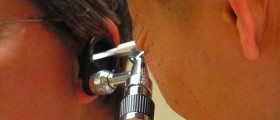
The ear is organ that enables us to detect sounds. But, this organ also has the another significant role to keep balance and body position. The ear consists of three different sections: the outer ear, the middle ear and the inner ear. The outer ear is visible part of the ear called auricle or pinna and its role is to collect sound waves. It also includes ear canal that extends to the eardrum which separates the outer from the middle ear. The middle ear begins at the end of the ear drum and is made of three tiny bones: malleus, incus and stapes. The inner ear consists of sensory organs important for hearing and balancing. The ear is a delicate organ that can be affected by numerous problems such as ear infections, hearing loss, Meniere’s disease, acoustic neuroma, tinnitus and migraine associated vertigo.
Ear InfectionsEar infections occur due to growth of germs such as bacteria, viruses or fungi inside the ear. The infection can affect outer, middle or inner ear. Ear infection is associated with earache, fever, dizziness, trouble hearing and ear blockage. Otitis externa or swimmer’s ear is an infection of the outer ear. Typically, the infection is caused by bacteria but sometimes it may be fungi. This infection often occurs when excess water enters the ear canal so it is often seen among those who frequently swim. Accumulation of earwax and allergies can also contribute development of this infection. Symptoms of otitis externa include itching, pain, swollen ear canal and redness. Infection of the middle ear or otitis media can be due to bacterial or viral infection. Otitis media can be acute or chronic. The condition is common in children. Allergies, infections, malnutrition or clogged eustachian tube can lead to this infection. The symptoms include strong pain, tinnitus and hearing loss. Otitis interna or labyrinthitis is infection of the inner ear that can be caused by sinus or throat infection. The symptoms are dizziness, nausea, vomiting, tinnitus and hearing loss.
Hearing Loss
This condition represents partial or complete inability to hear. It may affect one or both ears and can be temporary or permanent. It can be due to ear infections, ear injury, aging process, genetic disorders and certain factors present at birth such as premature birth. Other possible causes include use of certain medications, skull fracture, and eardrum rupture. Types of hearing loss are functional, sensorineural, conductive, central and mixed hearing loss.
Tinnitus
Tinnitus is a noise or ringing in the ears. It most commonly results from inner ear cell damage but can be also caused by loud noise exposure, ear trauma, hearing loss, earwax blockage or neurological disorders. Brain tumor, Meniere’s disease, use of certain medications and head injury are less common causes of tinnitus.
Meniere’s DiseaseMeniere’s disease is a disorder of the inner ear. The condition causes recurring episodes of vertigo, nausea, vomiting, tinnitus, hearing loss and aural fullness. It is commonly caused by middle ear infection, head injury or syphilis. Triggers for the disease include allergies, smoking and respiratory infections.

















Your thoughts on this
Loading...